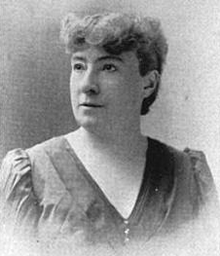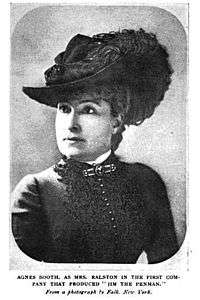Agnes Booth
| Agnes Booth | |
|---|---|
 Agnes Booth | |
| Born |
October 4, 1843 Sydney, New South Wales |
| Died | January 2, 1910 (aged 66) |
| Other names | Marion Agnes Land Rookes |
| Occupation | Actress |
Agnes Booth (October 4, 1843 – January 2, 1910), born Marion Agnes Land Rookes, was an Australian-born American actress and in-law of Junius Brutus Booth, John Wilkes Booth, and Edwin Booth.
Biography

She was born in Sydney, New South Wales, but migrated to California, United States, in 1858 at the age of 14. At age 16, she married Harry Perry in 1861 in San Francisco but was widowed in 1863.[1]
She performed in California, attracting attention and gaining recognition, until 1865 when she moved to New York where she appeared at the Winter Garden (demolished in 1867). In 1866, she joined the Boston Theatre Company, of which she was a member for several years. In 1867, she was married to Junius Brutus Booth, Jr., its manager. Mr. Booth died in 1883, and in 1885 she remarried to John B. Schoeffel.
In 1878 she played Madeleine Renaud in the Union Square Theatre's production of "A Celebrated Case," the program noting that she had "kindly undertaken this part in order to strengthen the cast." From 1881 to 1891, she was with the Madison Square Company. After 1891, she went to Europe, then returned to the United States where she resided in the artist community of New Rochelle, New York and resumed her work on Broadway in nearby New York City. Booth gained fame for her role in the melodrama The Sporting Dutchess along fellow actress and New Rochelle neighbor Cora Tanner.[2]
Reviews
From Belford's Magazine [2:8] (January 1889):
"Agnes Booth has scored a great triumpth as Mrs. Seabrook in "Captain Swift" at the Madison Square. For painstaking attention to detail, nicety of intonation, and powerful expression, Agnes Booth is in the front rank of leading ladies. We have seen her in many society dramas, and in each she has shown a charming appreciation of all the requirements. At the Madison Square, with its cosey (sic) stage, the visitor forgets that he is one of the audience, and feels almost like an intruder upon a scene in a private drawing-room. ... The mingled expression of shame, suffering and maternal love in Agnes Booth's face during [one] scene is one not soon to be forgotten. The audience remains spellbound a moment, then a burst of enthusiastic applause crowns her effort."
References
- ↑ "Marion Agnes Land Rookes Booth". Find-a-Grave. Retrieved 18 May 2016.
- ↑ New York: A Guide to the Empire State; The Workers of the Writers' Program of the Works Projects Administration in the State of New York; Page.244
Sources
- Find A Grave
- Asia Booth Clarke (1882). The Elder and the Younger Booth, Boston: J.R. Osgood and Co.
- McKay and Wingate (1896). Famous American Actors of To-day, New York: T. Y. Crowell.
- Clapp and Edgett (1899). "Players of the Present", Dunlap Society Publication. New York.
- Montrose Jonas Moses (1906). Famous Actor-Families in America, New York: Greenwood Press.
External links
- "AGNES BOOTH TO ACT ONCE MORE; The Popular Actress Will Create the Role of the Sporting Duchess at the Academy.". New York Times. February 12, 1895. Retrieved 2008-08-07.